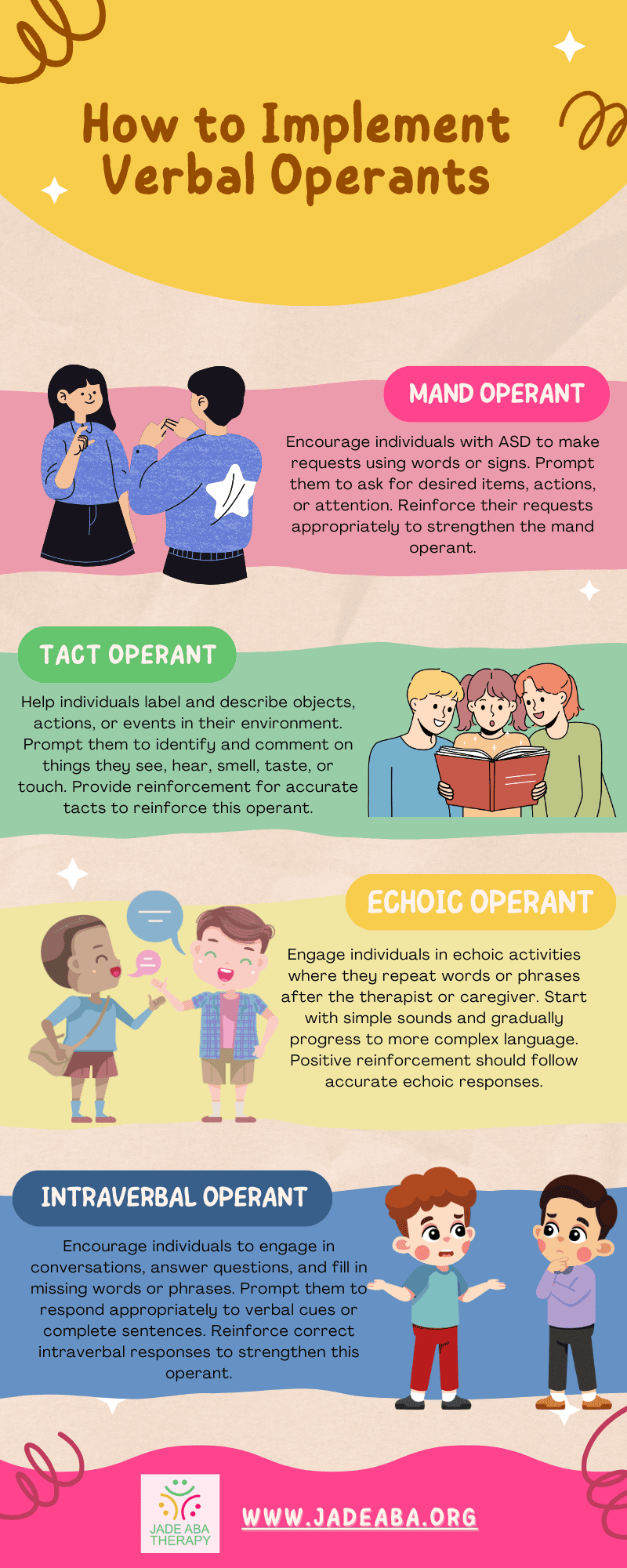Verbal operants are fundamental units of language that encompass various functional categories. Identified by B.F. Skinner, these operants provide a framework for understanding and developing language abilities.
Understanding and utilizing these operants is crucial for individuals with ASD as it helps them develop effective communication skills and enhance their quality of life. Verbal operants provide a structured approach to language development, and this allows therapists and caregivers to teach and reinforce specific communication behaviors systematically.
By focusing on verbal operants, therapists can move beyond simple labeling and help individuals with ASD understand the purpose and utility of words. This enables them to make requests, express their needs, share ideas, and engage in meaningful social interactions.

Types of Verbal Operants
Verbal operants play a significant role in Applied Behavior Analysis (ABA) therapy for individuals with autism spectrum disorder (ASD). These operants encompass various categories, each serving a unique function in developing language and communication skills.
Let’s look at each of them.
Mand Operant
The mand operant focuses on the speaker’s ability to make requests or ask for what they want or need. It involves using language to communicate desires or seek attention.
For example, a child may say, “Can I have some water?” or text a friend to ask for their attention. The mand operant is essential for individuals to express their needs effectively.

Tact Operant
The tact operant involves labeling or naming things and actions that the speaker directly experiences through any of their senses. It allows individuals to describe and communicate about their environment.
For instance, if someone smells a pie, they might say, “Wow, it smells like blueberry pie.” The tact operant helps individuals expand their vocabulary and develop expressive language skills.
Echoic Operant
The echoic operant focuses on the individual’s ability to repeat or imitate the words or sounds of another speaker. This operant is crucial for learning to speak and expanding verbal behavior.
By repeating words heard from others, individuals acquire new vocabulary and develop their language skills. Echoic behavior serves as a foundation for further language development.
Intraverbal Operant
The intraverbal operant involves responding to another person’s verbal behavior. It allows individuals to engage in conversation and answer questions based on what is being said, even in the absence of the actual object or topic.
For example, when asked, “What does A stand for in the three-term contingency?” an individual might respond with “Antecedent.” The intraverbal operant contributes to fluent conversation and the ability to understand and respond appropriately to questions.
The different types of verbal operants are crucial building blocks within any ABA program aimed at teaching language and communication skills to individuals with autism. By targeting these operants, therapists and caregivers can assess and develop the language skills of individuals with ASD, enabling them to effectively express their needs, label their experiences, imitate speech, and engage in meaningful conversations.
Practical Applications
Implementing verbal operants in Applied Behavior Analysis (ABA) therapy can be highly beneficial for individuals with autism spectrum disorder (ASD) in developing language and communication skills. ABA therapists and caregivers play a crucial role in utilizing verbal operants effectively.
Here, we will explore the practical applications of implementing verbal operants and customizing therapy approaches to meet individual needs.
Implementing Verbal Operants
To implement verbal operants, therapists and caregivers can use specific techniques and strategies during therapy sessions and daily interactions. Here are some practical ways to implement them:

By implementing these verbal operants during therapy sessions and daily interactions, individuals with ASD can develop their language and communication skills.

Customizing Therapy Approaches
Customizing therapy approaches based on the individual needs of each person with ASD is essential for effective outcomes. Here are some considerations for customizing such approaches:
- Assessment – Begin by conducting a comprehensive assessment to identify the individual’s current language and communication abilities. This assessment helps determine the starting point and specific goals for therapy.
- Individualized Goals – Set individualized goals that align with the person’s unique needs and abilities. These goals may focus on specific verbal operants, such as increasing manding skills or expanding vocabulary.
- Visual Supports – Utilize visual supports, such as visual schedules, social stories, and communication boards, to enhance understanding and support communication. Visual supports can help individuals with ASD comprehend and express their thoughts effectively.
- Reinforcement – Determine the most effective reinforcers for the individual. Different individuals may respond better to different types of reinforcement, such as praise, tokens, or preferred items. Use positive reinforcement consistently to motivate and reinforce progress.
- Generalization – Practice verbal operants in various settings and with different people to promote the generalization of skills. This helps individuals transfer their language and communication abilities to real-life situations.
Customizing therapy approaches ensures that the interventions are tailored to the individual’s specific needs, maximizing the effectiveness of verbal operants in promoting language development and enhancing communication skills.
By implementing verbal operants and customizing therapy approaches, individuals with ASD can make significant progress in their language and communication abilities. The involvement of therapists and caregivers is crucial in creating a supportive and enriching environment that fosters growth in these essential areas.
Sources:
https://www.appliedbehavioranalysisprograms.com/faq/verbal-operants
https://howtoaba.com/verbal-operants
https://learningbehavioranalysis.com/b-14-verbal-operants
https://www.autismparentingmagazine.com/verbal-operants-autism
https://hopeeducationservices.com/what-are-the-verbal-operants-and-why-do-they-matter